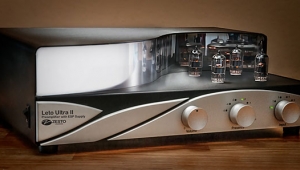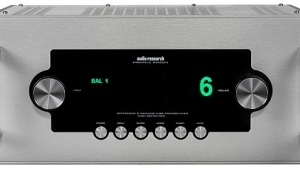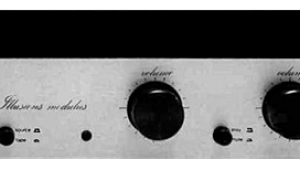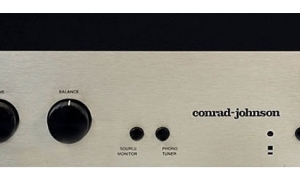| Columns Retired Columns & Blogs |
Jadis RC JP80 MC Mk.II preamplifier
"It costs as much as a car—and not a used jalopy, either." That's what goes through your head as you contemplate this magnificent $20,190 piece of audio jewelry. I don't mean "jewelry" pejoratively; the tubed Jadis RC JP80 MC Mk.II is a gorgeous, gleaming hunk of retro-looking machinery. Two hunks, actually: an equally large remote power supply is connected via an umbilical cord terminated with an elbow connector the size of house plumbing.
Hand-built in France, Jadis gear has long held a reputation for a Rolls-Royce-like level of sonic luxury—or should I say Citroen-like? From what I've gathered from current owners, the reliability problems—mostly with the power amps—that plagued the line when it was first imported in the mid-1980s should no longer concern prospective purchasers. I encountered none myself during the many months I had the JP-80 in and out of my system.
The preamp includes both MM and MC phono inputs, plus four line-level inputs—two Aux, CD, and tuner—all selectable via a row of electronically controlled black pushbuttons. There's also a toggle-switched tape loop that routes only the selected source to the tape-out jacks—you can't tape one source while listening to another—plus switches for muting, balance, and volume. When you fire up the JP80 via the power-supply-mounted On/Off switch, it defaults to Phono, as it should. It's unlikely that anyone buying this baby is going to be listening only to CDs—or to any CDs at all.
Turn-on cycle time is frustratingly long—about five minutes—but believe me, it's worth the wait! While the massive, complex power supply is filled with solid-state devices visible through the chassis cage, voltage rectification is via two tubes, an EL86 and an EF86.
The preamp's tube complement consists of six 12AX7s and two 6DJ8s. Neither the importer nor (according to the importer) the manufacturer was willing disclose circuit details, which was fine with me. And while it was tempting to replace the Chinese and Soviet tubes (some with CCCP stamped on them) with Bugle Boy Amperex ECC88s (6DJ8) and vintage Telefunken 12AX7s (with the diamond pattern on the bottom glass), I decided not to mess with the unit, and reviewed it as delivered.
But if you're going to consider spending $21k on a preamp, you're at least entitled to know about its build quality; so I popped the chrome chassis bottoms off of both units to have a look inside. You get your money's worth. While there are printed circuit boards for the input, source selection, and remote-control sections of the design, most of the rest of the circuitry, including all signal paths, is realized with incredibly tidy, labor-intensive, three-dimensional point-to-point wiring featuring thick, solid-copper bus bars arranged in a visually appealing and, I would hope, sonically effective manner.
Workmanship is breathtaking, and parts quality appears to be very high. The "Mk.II" appellation refers to changes made to the original model that lower noise and make the unit's high-gain phono section less susceptible to RF interference. (I encountered few problems in this regard—just the usual fundamentalist Christian AM station out of South Carolina that occasionally appears on most phono sections I audition—and a hum when I used my 900MHz digital telephone.)
Physically at least, everything about the Jadis RC JP80 MC Mk.II is designed to instill in its owner that pride of ownership to which one is entitled when spending this kind of money on a preamplifier—or on any other product. But put that price into perspective: I recently went to the debut of Sony's first consumer HDTV, a large, flat-screened, magnificent-looking direct-view model. Cost, including stand? $9000. HDTV broadcast picture quality? Breathtaking.
Remote possibilities
Jadis' first remote-controlled preamplifier gives you complete authority over the unit: volume, balance, source, and mute. The handheld remote can also control a Jadis CD player. I was assured by the importer that the crappy, plastic, fit-for-a-Samsung-CD-player remote supplied with my review sample was only temporary. For $21k you're entitled to the kind of controllers, nicely machined from solid aluminum, that EAD, Ayre, and other high-end manufacturers supply; I have no doubt [Here's hoping?] that's what Jadis will eventually put in purchasers' hands.
It doesn't take more than a few seconds to size up what's wrong with the remote-control system: motor overshoot. Getting either the volume or balance controls to stop where you want them to is a skill akin to learning a video game. And even after you figure out the lag time between taking your finger off the button and the motor's stopping, precision is impossible. Nonetheless, once I got used to the overshoot, I was able to achieve levels that were acceptable, if never precise. I didn't use the balance control—in my opinion, a product costing this much cries out for an ultra-high-quality stepped attenuator. But I'm open to any good argument to the contrary.
Gain ballet
The JP-80 Mk.II's all-tube phono section possesses sufficient gain to handle even the lowest of low-output moving-coil cartridges. It didn't break a sweat with either the Parnassus D.C.t or the Transfiguration Temper, both of which are rated at 250µV. I never had to move the volume control beyond the halfway point. For an all-tube design, noise at any reasonable listening level—even with the quietest solo acoustic music—was extremely low, and not audible. A very impressive performance. Not quite as impressive is the lack of variable loading facilities, which I find inexcusable in a product at this price. The MC section comes pre-loaded at 35 ohms.
That gripe out of the way, I can tell you that the JP80 produced the most convincingly real sonic pictures of acoustic instruments I've heard in my home. The preamp's rendering of a piano was so immediately superior to anything else I've heard that I was moved in the first week of auditioning to play more solo-piano recordings than I've played in five years.
Rubinstein at Carnegie Hall (RCA LSC-2605), a live solo recital brilliantly recorded by Anthony Salvatore 37 years ago, puts Rubinstein's piano stage left (near the right speaker) from a fairly close perspective. The JP80's portrayal was so transparent, so harmonically rich, so fundamentally convincing—tonally, dynamically, spatially—that I could hardly believe what I was hearing. Look, this recording can make a Sears Silvertone portable sing; on any merely good system, it works magic. But the JP80's version was exceptional.
For one thing, the touch of Rubinstein's fingers on the keys was closer to the sensation you feel and hear watching a live performance than anything I'd previously encountered while listening to a record. The JP80 served up the piano's rich harmonics—the acoustic envelope of the notes as they were sounded, and the continuing sustain of notes previously played—better than I've ever heard before. The consistency with which it rendered both the lower and upper registers of the instrument was also superior to what I've previously experienced. Never mushy on bottom or brittle on top, the JP80 delivered a piano.
The image of the piano itself, which so often "looks" either watery and indistinct or hard and compacted—or both, depending on the tonal region being sounded—floated convincingly and solidly in three dimensions on the stage (though the recording sometimes shifts the picture in odd, disconcerting bursts).
Once I heard what the JP80 could do with that recording, I pulled out The Horowitz Collection (LD-7021), a gorgeous RCA Soria box of mono LP recordings, some of them fairly old. Again, the Jadis delivered a credible picture, tonally, dynamically, and even spatially, despite the single-channel recordings.
During that lengthy listening session I moved on to Capitol's wonderful Laurindo Almeida guitar recordings, some mono, some stereo, which were also rendered as close to the touch and tonality of the real event as I've heard at home. On Duets with Spanish Guitar (P 8406), Almeida is accompanied by flutist Martin Ruderman and singer Salli Terri—a contralto who sounds here as if she's imitating a Theremin. While this isn't one of the best recordings in the series, the JP80 easily fleshed out the distinctive textures and harmonic structures of the monophonically recorded guitar, voice, and flute, neatly folding each into its own harmonic envelope.
Then it was on to Clarinet Summit (India Navigation IN-1062), a natural, open-sounding live quartet recording. Same superbly accurate tonality, with David Murray's growling bass clarinet distinctively set against the three other instruments. The JP80 achieved a truly physical sense of "thereness," though I've heard better renderings of the recording space.
- Log in or register to post comments




































